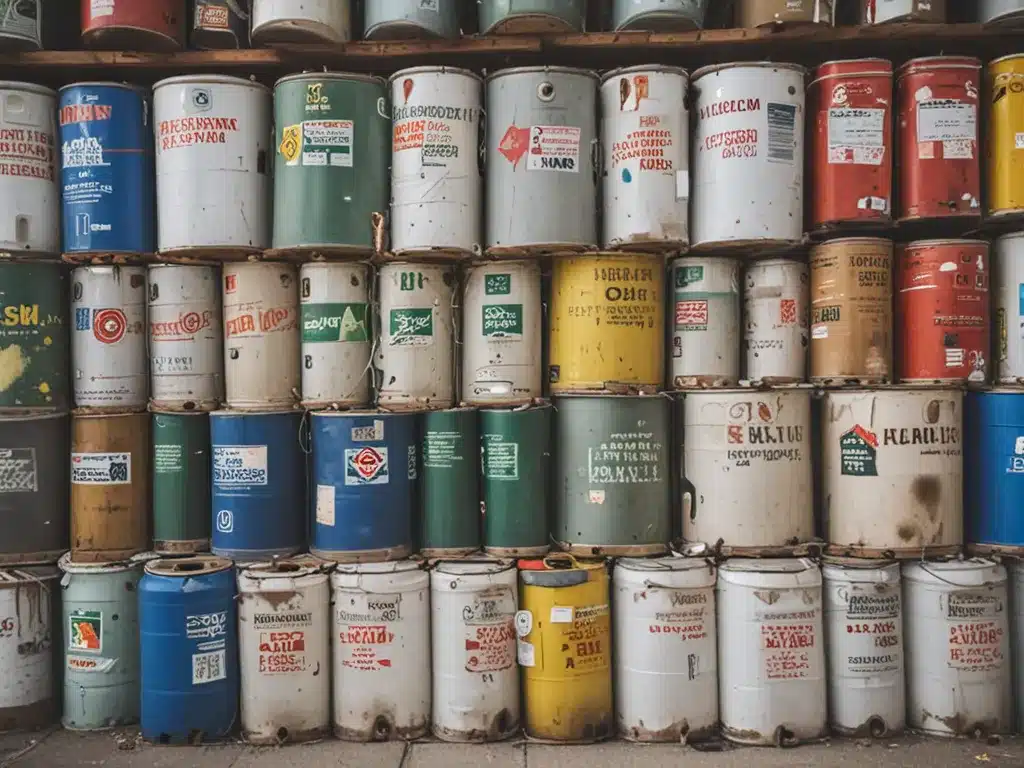As a homeowner, I am aware that certain common household items can be hazardous and require special disposal. Improperly disposing of these materials can be harmful to human health and the environment. Here is what I’ve learned about properly managing my household’s hazardous waste:
Identifying Household Hazardous Waste
Household hazardous waste includes products that contain corrosive, toxic, ignitable, or reactive ingredients. Here are some examples of common household hazardous products:
- Cleaning supplies like oven cleaners, drain cleaners, rust removers, and floor and furniture strippers
- Automotive supplies like antifreeze, brake fluid, transmission fluid, and used motor oil
- Paint supplies like paint thinners, turpentine, stains, and varnishes
- Pesticides like weed killers, insect repellents, roach powder, rat poison
- Batteries like button batteries, rechargeable batteries, lead-acid batteries
- Mercury-containing products like CFL light bulbs, thermometers, thermostats
I check product labels for words like “warning,” “hazardous,” “toxic,” “corrosive” to identify household hazardous products. I also check products containing gasoline, kerosene, or solvents.
Risks of Improper Disposal
Improperly disposing of household hazardous waste can pose risks:
- Pouring chemicals down the drain can pollute waterways.
- Putting chemicals in the trash can harm sanitation workers.
- Chemicals can leach from landfills into groundwater.
- Burning hazardous materials can release toxic fumes.
- Liquid hazmat left in containers can spill and contaminate soil.
Safe Storage
Until I can properly dispose of hazardous products, I make sure to store them safely:
- I keep products in their original containers, closed tightly.
- Containers are stored upright and away from direct sunlight or heat sources.
- Hazardous materials are segregated from each other and stored up high, out of reach of children and pets.
- A spill kit is handy to contain leaks or spills.
Local Disposal Options
My municipality offers the following options for properly disposing of household hazardous waste:
- Permanent collection facility – I can drop off hazmat at the local recycling center year-round during open hours.
- Temporary/mobile collection events – A few times per year the city hosts weekend collection events at rotating locations.
- Curbside pickup – For a fee, the city will collect certain hazardous items with the regular trash pickup.
- Mail-back programs – For certain waste like batteries or CFL bulbs, I can use pre-paid mailers to ship to recycling centers.
Before I drop off materials, they need to be properly sorted and contained. The facility may have limits on what they can accept.
I should call ahead to confirm what materials they will take and any other requirements.
Safe Handling Tips
When handling hazardous products:
- I wear gloves, goggles, and other protective equipment as needed.
- I work in a well-ventilated area and avoid breathing fumes.
- I never pour hazmat down drains or into the ground.
- I never mix chemicals or hazardous waste together.
- I keep materials away from ignition sources if flammable.
Disposal of Common Hazmats
Here are some guidelines I follow for disposing of typical hazardous household items:
Paint
- Completely dried latex paint cans can go in the regular trash.
- Oil-based paints and liquids require special disposal.
Cleaning Products
- I check if empty cleaner bottles can be recycled curbside after thoroughly rinsing.
- If not recyclable, non-empty containers go to the hazardous waste facility.
Automotive Fluids
- Used motor oil can be recycled at many auto parts stores or hazmat facilities.
- Other fluids like antifreeze require hazardous disposal.
Pesticides
- Completely empty pesticide containers can go in the regular trash.
- Remaining pesticide liquids or solids get disposed of as hazmat.
Batteries
- Single-use alkaline batteries go in the regular trash.
- Rechargeable batteries get recycled through special disposal programs.
Fluorescent Light Bulbs
- CFLs and fluorescent tubes contain mercury and cannot go in household trash.
- I use my municipality’s CFL recycling program.
Disposal as a Last Resort
Whenever possible, I try to reduce my use of hazardous products through alternatives like green cleaning supplies.
For leftover products I cannot use up, I first check if they can be donated to local organizations.
As a last resort, I ensure responsible disposal through my municipality’s hazardous waste management program. Proper hazmat disposal helps protect health and the environment.







